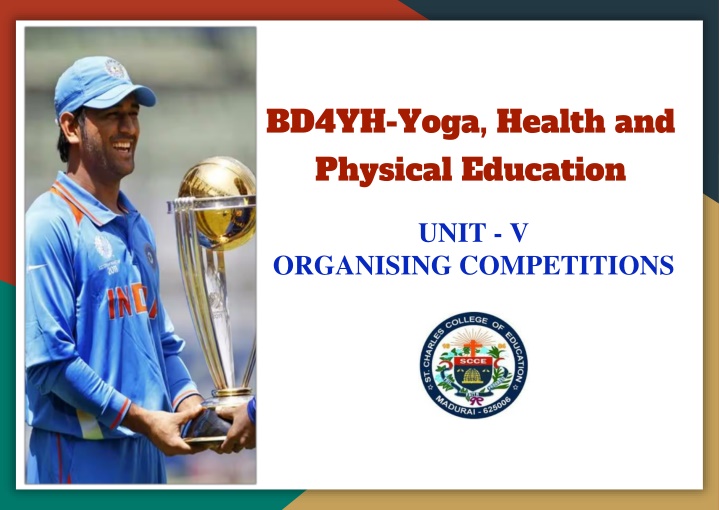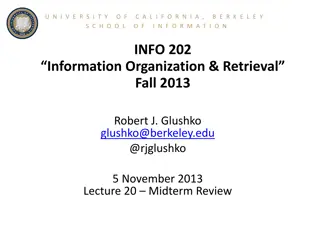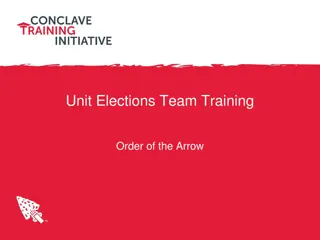
Organising Intramural Competitions for Physical Education Development
Learn about the importance, objectives, and strategies for organizing intramural competitions within educational institutions. Discover how these competitions promote physical activity, skill development, teamwork, and leadership qualities among students. Get insights into forming competition units and conducting events effectively.
Download Presentation

Please find below an Image/Link to download the presentation.
The content on the website is provided AS IS for your information and personal use only. It may not be sold, licensed, or shared on other websites without obtaining consent from the author. If you encounter any issues during the download, it is possible that the publisher has removed the file from their server.
You are allowed to download the files provided on this website for personal or commercial use, subject to the condition that they are used lawfully. All files are the property of their respective owners.
The content on the website is provided AS IS for your information and personal use only. It may not be sold, licensed, or shared on other websites without obtaining consent from the author.
E N D
Presentation Transcript
BD4YH-Yoga, Health and Physical Education UNIT - V ORGANISING COMPETITIONS
Introduction to Intramural Competitions Definition: Intramural means "within the walls" and refers to competitions held within an institution. These competitions are essential for promoting physical activity and camaraderie among students. Purpose: The primary aim is to develop sports skills, enhance physical fitness, and provide incentives for participation among students, creating a sense of belonging and achievement. Participation: The goal is to achieve 100% participation, encouraging every student to get involved. This fosters leadership, teamwork, and a sense of community. Knowledge and Social Skills: Participants gain a thorough understanding of game rules and regulations, which promotes fair play and cooperation among peers, enhancing social skills. Enjoyment: Intramural activities are designed to provide fun and enjoyment, helping students relieve stress and build a positive attitude towards physical education.
Objectives of Intramural Competitions Skill Development: Focus on improving students' abilities in specific sports and activities. Skills learned during intramurals can contribute to lifelong physical activity. Incentives: Offering rewards and recognition for participation and achievement helps motivate students to engage actively and strive for excellence. Leadership Qualities: Intramural activities provide opportunities for students to develop and exhibit leadership and followership qualities, preparing them for future roles. Knowledge of Rules: Teaching the rules of various games ensures that competitions are fair and orderly, promoting a culture of respect and sportsmanship. Social Qualities: Intramurals foster important social qualities like teamwork, respect, cooperation, and the ability to handle both victory and defeat gracefully.
Conducting Intramural Competitions Institution Type: The nature of the institution, whether residential, non-residential, or partially residential, influences the organization of intramural competitions. Local Conditions: Adapting to local and climatic conditions is crucial for scheduling events appropriately, ensuring maximum participation and safety. Available Facilities: Utilizing available playgrounds, equipment, and leadership resources effectively is key to the success of intramural competitions. Financial Resources: Managing funds effectively ensures that competitions are well-organized and sustainable, allowing for a variety of activities. Time Management: Efficient scheduling within the academic calendar ensures that competitions do not interfere with academic responsibilities and other school activities.
Forming Units for Competition Equal Ability Teams: Dividing students into teams of equal ability ensures fair competition and encourages balanced participation from all. Resident Institutions: In residential institutions, competitions are often organized on an inter-hostel or house basis, fostering a sense of identity and belonging. Partially Residential: In partially residential institutions, teams can be formed by mixing hostel residents and day scholars, promoting unity and collaboration. Non-Residential: In non-residential institutions, units can be formed based on class or index basis, ensuring that every student has a chance to participate. College Units: In colleges, competitions are typically organized on a class or departmental basis, encouraging inter-departmental interaction and competition.
Intramural Committee Structure Director: A senior physical education teacher typically serves as the intramural director, overseeing the organization and execution of events. Assistant Directors: Other physical education teachers act as assistant directors, helping to manage various aspects of the competitions. Student Leaders: Elected student leaders, including a secretary and joint secretary, play a crucial role in organizing and promoting intramural activities. Rules and Regulations: The committee is responsible for framing rules for competitions, ensuring fair play, and handling any protests or disputes that arise. Record Keeping: Maintaining accurate records of meetings, results, and score sheets is essential for transparency and the smooth functioning of intramural events.
Suitable Activities for Competitions Major Games: Activities such as basketball, soccer, cricket, and other popular sports are included to cater to diverse interests and talents. Swimming and Track Events: Organizing swimming, running, and other track and field events provides a wide range of options for students to showcase their abilities. Tumbling and Pyramids: Incorporating gymnastics and acrobatic activities adds variety and allows students to explore different physical skills. Defensive Arts: Including martial arts and self-defense activities helps students develop confidence and discipline while learning valuable self-protection skills. Rhythmic Activities: Engaging students in dance and rhythmic exercises promotes creativity, coordination, and physical fitness, making intramurals more inclusive.
Timing of Intramural Competitions Year-Round: Competitions can be conducted throughout the academic year, ensuring continuous engagement and physical activity. Heavy Program: The first and second terms can have a heavy schedule of activities, maximizing participation before the academic load increases. Light Program: The third term might have a lighter schedule due to exams, allowing students to focus on academics while still participating in some activities. After School Hours: Scheduling competitions after school hours and on holidays ensures that they do not interfere with academic commitments. League and Knockout: Events can be conducted on a league or knockout basis, offering different formats to keep competitions exciting and varied.
Scoring in Intramural Competitions Point System: A point system is used to award points based on team performance in each activity, encouraging consistent effort across all events. Unit Scores: Points are credited to the overall unit score, fostering a sense of collective achievement and encouraging teamwork. Score Sheets: Maintaining detailed day-to-day and permanent score sheets ensures transparency and helps track progress over time. Intramural Champions: The overall intramural champion unit is decided based on the total points accumulated, adding a competitive edge to the events. Fair Play: Ensuring fairness and consistency in scoring is crucial for maintaining the integrity of the competitions and fostering a positive atmosphere.
Awards and Recognition Activity Winners: Winners in each activity are recognized with shields, medals, and certificates, celebrating their achievements participation. and encouraging continued Champion Unit: The overall intramural champion unit is awarded a trophy, fostering a sense of pride and accomplishment among team members. Honor Board: A photograph of the champion unit is displayed on an honor board, serving as a lasting recognition of their success and inspiring others. Encouraging Participation: Awards and recognition are used to motivate students to participate actively and strive for excellence in all activities. Maintaining Records: Keeping an honor board with names and achievements helps document the history of intramural competitions and recognizes past champions.
Encouraging Participation Balanced Teams: Ensuring teams are balanced in terms of skill and ability makes competitions fairer and more enjoyable for all participants. Limited Activities: Restricting the number of activities a student can join ensures that more students have the opportunity to participate and excel. Variety of Activities: Offering a wide range of activities caters to different interests and talents, maximizing student involvement and utilization of facilities. Extra Points: Awarding extra points for participation in less popular activities encourages students to try new things and ensures a well-rounded program. 100% Participation: Providing additional points for full participation motivates teams to engage every member, fostering a sense of inclusion and teamwork.
Introduction to Extramural Competitions Definition: Extramural competitions are inter-institutional events, providing opportunities for students to compete with peers from other institutions. Opportunities: These competitions offer a platform for students to represent their institutions, enhancing their sense of pride and belonging. Skill Improvement: Participation in extramural competitions helps students improve their skills through exposure to different levels of competition. Institutional Loyalty: Competing for one's institution fosters loyalty and a sense of responsibility, encouraging students to perform their best. New Friendships: Extramural competitions provide opportunities to build new friendships and connections with peers from different institutions.
Benefits of Extramural Competitions Improved Performance: The competitive nature of extramural events drives students to enhance their skills and perform better. Leadership Development: Participating in extramural competitions helps develop leadership and sportsmanship qualities, preparing students for future challenges. Cultural Exchange: Traveling to different places for competitions exposes students to new cultures and environments, broadening their perspectives. Enjoyment: Extramural competitions offer a break from routine, providing pleasure and enjoyment through healthy competition. Knowledge Sharing: Competing with peers from other institutions allows students to learn new techniques and strategies, enhancing their overall knowledge.
Drawbacks of Extramural Competitions Questionable Methods: The pressure to win can sometimes lead to the use of unfair means, compromising the integrity of the competition. Unhealthy Rivalry: Intense competition can lead to unhealthy rivalry and jealousy among participants, which needs to be managed carefully. Resource Drain: Extramural competitions can be resource-intensive, requiring significant time, money, and energy from both students and institutions. Student Strain: The physical and mental demands of frequent competitions can strain students, impacting their academic performance and well-being. Discipline Issues: Ensuring discipline and sportsmanship is crucial to maintaining a positive and respectful competitive environment.
Organizing Extramural Competitions Practice Matches: Arranging practice matches with neighboring institutions helps students prepare and gauge their readiness for official competitions. Closed Competitions: Conducting closed competitions with specific institutions ensures a controlled environment and manageable logistics. Open Competitions: Hosting open competitions invites participation from a broader range of institutions, enhancing the level of competition. Affiliation Fees: Managing membership and affiliation fees is essential for participating in organized leagues and associations. Zonal Competitions: Organizing competitions within zones helps manage larger events effectively, ensuring smooth operations and fair play.
Standard Sports Meet Pre-Meet Work: Extensive planning and preparation are required, with various committees handling different aspects of the meet. Publicity Committee: Announcing event details through media, posters, and announcements ensures maximum participation and awareness. Grounds Committee: Preparing the venue, setting up equipment, and ensuring all facilities are ready for the events. Officials Committee: Appointing competent officials to oversee the events and ensure they run smoothly and fairly. Accommodation Committee: Arranging accommodation and hospitality for participants, ensuring their comfort and convenience.
Conducting the Meet Opening Ceremony: The meet begins with a grand opening ceremony, including a march past, torch lighting, and the taking of an oath to uphold sportsmanship. Event Execution: Events are conducted according to the schedule, with efficient time management and coordination ensuring everything runs smoothly. Victory Ceremony: Winners are awarded immediately after their events, providing instant recognition and motivation. Closing Ceremony: The meet concludes with a formal closing ceremony, including the distribution of trophies, medals, and certificates. National Anthem: The meet ends with the national anthem, instilling a sense of pride and unity among all participants.
Post-Meet Activities Settling Accounts: Finalizing all financial matters, ensuring that all expenses are accounted for and any surplus is managed properly. Returning Equipment: Ensuring all borrowed materials and equipment are returned in good condition, maintaining good relationships with suppliers and partners. Thank You Letters: Sending appreciation letters to all helpers, sponsors, and participants, acknowledging their contributions to the success of the event. Record Maintenance: Keeping detailed records of the meet, including results, participant details, and feedback, for future reference and improvement. Feedback Collection: Gathering feedback from participants and officials to identify areas for improvement and enhance future events.
Non-Standard Sports Meet Definition: Non-standard sports meets involve competitions with special rules tailored for convenience and to encourage broader participation. Team Focus: Emphasizing team performance over individual achievements promotes unity and collective effort. Mass Athletics: Organizing events that accommodate large groups of students, ensuring maximum participation and engagement. Handicap Sports: Adjusting rules to give weaker participants a fair chance, promoting inclusivity and equal opportunity. Telegraphic Sports: Comparing performances from different locations through telegraphic methods saves time and resources while still fostering competition.
Mass or Team Athletics Follow-On Method: Relay races where team members pass the baton to each other, encouraging teamwork and coordination. Shuttle Method: Shuttle relays with teams split into two halves, adding variety and excitement to the competition. Zonal Method: Awarding points based on zonal distances covered, promoting strategic planning and collective effort. Track Events: Organizing various track events suitable for large teams, ensuring diverse participation and skill demonstration. Scoring: Adding individual points to determine team winners, fostering a sense of collective achievement and fair play.
Enhancing Participation in Non-Standard Meets Equal Opportunity: Ensuring that all students, regardless of skill level, have the chance to compete and enjoy the activities. Encouraging Effort: Motivating weaker participants to put in their best effort, helping them build confidence and improve their skills. Cost Efficiency: Utilizing telegraphic sports methods saves time and money, making it easier to organize and manage events. Team Spirit: Promoting teamwork and group effort through non-standard events, enhancing the overall experience and camaraderie. Innovative Events: Introducing creative and engaging events keeps the competition exciting and encourages continuous participation.
Conclusion Summary of Intramural Competitions: Highlighting the importance of intramural activities in fostering skills, leadership, and teamwork among students within an institution. These competitions are crucial for overall student development. Summary of Extramural Competitions: Emphasizing the role of inter-institutional events in enhancing performance, promoting institutional loyalty, and offering new learning experiences. These events broaden students' horizons and skills. Benefits and Challenges: Reviewing the benefits such as improved performance, cultural exchange, and enjoyment, along with challenges like unhealthy rivalry and resource management. Addressing these challenges is key to successful competitions. Organizational Insights: Summarizing key organizational aspects, including committee structures, scheduling, and the importance of fair play and proper record-keeping. Effective organization ensures the smooth running of events. Future Directions: Encouraging continuous improvement in organizing both intramural and extramural competitions to ensure they remain enjoyable, inclusive, and beneficial for all participants. Adapting to new trends and feedback is essential for future success.





















